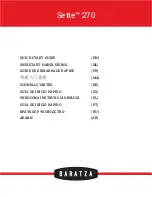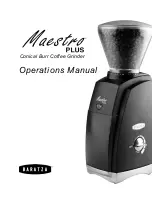
ENGLISH • 15
When assessing vibration exposure to determine safety
measures required by 2002/44/EC to protect persons
regularly using power tools in employment, an estimation
of vibration exposure should consider, the actual
conditions of use and the way the tool is used, including
taking account of all parts of the operating cycle such
as the times when the tool is switched off and when it is
running idle in addition to the trigger time.
FEATURES (Fig. A)
1. On/off switch
2. Lock-off button
3. Side handle
4. Spindle lock
5. Guard
ASSEMBLY
Warning! Before assembly, make sure that the tool is
switched off and unplugged.
Fitting and removing the guard (Fig. B)
The tool is supplied with a guard intended for grinding
purposes only. If the unit is intended to perform cutting off
operations, a guard specific for this operation must be fitted.
Fitting
f
Place the tool on a table, with the spindle (6) facing up.
f
Release the clamping lock (7) and hold the guard (5)
over the tool as shown.
f
Align the lugs (8) with the notches (9).
f
Press the guard down and rotate it counterclockwise
to the required position.
f
Fasten the clamping lock (7) to secure the guard
to the tool.
f
If required, tighten the screw (10) to increase
the clamping force.
Removing
f
Release the clamping lock (7).
f
Rotate the guard clockwise to align the lugs (8)
with the notches (9).
f
Remove the guard from the tool.
Warning! Never use the tool without the guard.
Fitting the side handle
f
Screw the side handle (3) into one of the mounting
holes in the tool.
Warning! Always use the side handle.
Fitting and removing grinding or cutting discs
(Fig. C - D)
Always use the correct type of disc for your application.
Always use discs with the correct diameter and bore size
(see technical data).
Fitting
f
Fit the guard as described above.
f
Place the inner flange (11) onto the spindle (6) as
shown
(Fig. C). Make sure that the flange is correctly
located onthe flat sides of the spindle.
f
Place the disc (12) onto the spindle (6) as shown
(Fig. C). If the disc has a raised centre (13), make
sure that the raised centre faces the inner flange.
f
Make sure that the disc locates correctly on
the inner flange.
f
Place the outer flange (14) onto the spindle. When
fitting a grinding disc, the raised centre on the outer
flange must face towards the disc (D1 in Fig. D).
When fitting a cutting disc, the raised centre on the
outer flange must face away from the disc (D2 in Fig. D).
f
Keep the spindle lock (3) depressed and tighten the
outer flange using the two-pin spanner (15) (Fig. E).
Removing
f
Keep the spindle lock (4) depressed and loosen the
outer flange (14) using the two-pin spanner (15) (Fig. E).
f
Remove the outer flange (14) and the disc (11).
Fitting and removing sanding discs (Fig. E & F)
For sanding, a backing pad is required. The backing pad is
available from your Stanley dealer as an accessory.
Fitting
f
Place the inner flange (11) onto the spindle (5) as
shown
(Fig. E). Make sure that the flange is correctly
located on the flat sides of the spindle.
f
Place the backing pad (16) onto the spindle.
f
Place the sanding disc (17) onto the backing pad.
f
Place the outer flange (14) onto the spindle with the
raised centre facing away from the disc.
f
Keep the spindle lock (3) depressed and tighten the
outer flange using the two-pin spanner (15) (Fig. E).
Make sure that the outer flange is fitted correctly and
that the disc is clamped tightly.
Removing
f
Keep the spindle lock (4) depressed and loosen
the outer flange (14) using the two-pin spanner (15)
(Fig. E).
f
Remove the outer flange (14), the sanding disc (17)
and the backing pad (16).
USE
Warning! Let the tool work at its own pace. Do not
overload.
f
Carefully guide the cable in order to avoid accidentally
cutting it.
f
Be prepared for a stream of sparks when the grinding
or cutting disc touches the workpiece.
Summary of Contents for STEL845
Page 3: ...FIG F 14 17 16 11 6...


































